-
 Art of Wellness Acupuncture & Traditional Chinese Medicine (TCM)11704 Wilshire Blvd, Suite 295, Los Angeles, CA, 90025
Art of Wellness Acupuncture & Traditional Chinese Medicine (TCM)11704 Wilshire Blvd, Suite 295, Los Angeles, CA, 90025
myartofwellness@gmail.com310-451-5522 Office Hours
MonClosedTue7:30 am --4 pmWed7:30 am --4 pmThu7:30 am -- 4 pmFri7:30 am -- 4 pmSat7:30 am -- 4 pmSunClosedOur office opens from Tuesdays to Saturdays 7:30 am to 4 pm, will be closed on Memorial day, Independent day, Labor day, Thanksgiving day, Christmas and New year.
-
Recent Posts
- Chinese New Year 2026: Year of the Horse
- Acupuncture and TCM Treatment for Perimenopause Symptoms
- How to Treat Insulin Resistance With Acupuncture and TCM
- How to Treat Metabolic Syndrome With Acupuncture and TCM
- How to Treat Syncope With Acupuncture and TCM
- How to Treat Thoracic Outlet Syndrome With Acupuncture and TCM
- How to Treat Dupuytren’s Contracture With Acupuncture and TCM
- How to Treat Nutcracker Syndrome With Acupuncture and TCM
- How to Treat Rosacea With Acupuncture and TCM
- How to Treat Perioral Dermatitis With Acupuncture and TCM
- Lymphatic Drainage With Acupuncture and TCM
- How to Treat Turf Toe With Acupuncture
- How to Treat Nerve Pain With Acupuncture and TCM
- How to Treat Watery Eyes With Acupuncture and TCM
- How to Treat Ovarian Cysts With Acupuncture and TCM
- How to Treat Dystonia With Acupuncture and TCM
- Sign up to receive news and updates and get my free report:“The Top 10 Reasons to Try Acupuncture”

November 2025 M T W T F S S 1 2 3 4 5 6 7 8 9 10 11 12 13 14 15 16 17 18 19 20 21 22 23 24 25 26 27 28 29 30
Pain
How to Treat Costochondritis With Acupuncture and TCM
By Qineng Tan, L.Ac. Ph.D. and Xiaomei Cai, L.Ac., Ph.D.

Chest pain? Rib pain, sternum pain? These can be costochondritis symptoms, caused by inflammation of the cartilage that connects the ribs to the sternum. Acupuncture and TCM can provide costochondritis treatment to relieve pain and inflammation.
Costochondritis is a pain condition caused by inflammation of cartilage in the rib cage. It can be scary, because the pain can feel like a heart attack or a symptom of heart disease.
It is quite common for people who are experiencing costochondritis pain to visit the emergency room complaining of chest pain. Almost 10% of ER visits are related to chest pain symptoms, and a significant number of those turn out to be related to something other than heart problems.
Sometimes called “chest wall pain syndrome,” or costosternal syndrome, costochondritis is considered a syndrome because it presents as a set of symptoms that often does not have a clear cause.
Possible causes of costochondritis include:
- Trauma or injury to the chest or ribs
- Persistent cough
- Repeated bouts of vomiting
- Chest or lung infection
- Allergies that affect the lungs
- Fibromyalgia
- Tietze syndrome
Suddenly doing some kind of heavy labor or intense workout that you’re not used to, that causes you to be winded, could cause inflammation of the chest. Playing contact sports in which you may be tackled or collide with another player or get hit hard with a ball in the chest could also cause costochondritis.
Tietze syndrome is a rare condition in which the cartilage connecting the ribs to the breastbone becomes inflamed and swollen. With Tietze syndrome, the pain and swelling in the chest is usually higher up, around the second and third ribs.
Costochondritis pain usually is felt more on the left side of the chest, radiating outward, and there isn’t any swelling involved.
Rib pain may be exacerbated when lying down, which can make it difficult to sleep comfortably.
Costochondritis is most commonly experienced by people in middle age (40-50s), but it can occur in children and adolescents, as well as adults.
In most cases, costochondritis is temporary. However, costochondritis pain can limit your activities and be debilitating for weeks, or even months. One study showed that up to a third of adults reported pain persisting beyond a year.
Acupuncture has been shown to help alleviate costochondritis pain, often in a matter of weeks.
Costochondritis Symptoms
Costochondritis pain can range anywhere from a slight tenderness to severe chest pain. In mild cases, the pain may go away in a matter of days, but in other cases, the pain can become serious.
Symptoms of costochondritis include:
- Sharp chest pain
- Chest pressure, chest ache, tenderness in breastbone
- Pain on the left side of chest, to the left of the breastbone
- Rib pain in more than one rib
- Pain radiating to shoulders and/or arms
- Chest pain when coughing, sneezing, or taking a deep breath
- Pain in chest when reaching up or twisting the torso
- Rib pain when lying down
- Pain when hugging someone
- Pain when putting on a seatbelt
Medical Diagnosis and Costochondritis Treatment
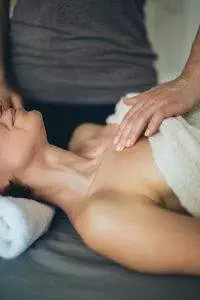
Other than the doctor palpating the area around your breastbone and ribs, there is no specific test to determine if you have costochondritis.
Chest pain can be an indicator of a variety of health conditions, including heart problems or lung problems, so it is always important to get it checked out with a healthcare professional. They will rule out other problems by ordering an EKG or chest X-ray in order to get to a diagnosis of costochondritis.
Treatment will consist of recommendations for ways to alleviate pain. Over-the-counter nonsteroidal anti-inflammatory drugs (NSAIDs) such as ibuprofen (Advil, Motrin IB) or naproxen (Aleve) can help reduce inflammation and pain.
In cases of more severe or persistent pain, a doctor may prescribe stronger pain medications such as prescription-strength Motrin or muscle relaxers.
Applying heat or cold packs to the affected area can help reduce inflammation and alleviate pain. Some individuals find relief by alternating between heat and cold therapy.
In cases where pain is severe and not responding to other treatments, corticosteroid injections directly into the affected area may provide temporary relief by reducing inflammation.
Acupuncture treatment is a great way to relieve pain and reduce inflammation, without the side effects that can result from using pain medications or steroids for several weeks or months.
Can Acupuncture Help Costochondritis?
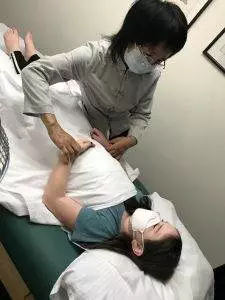
Acupuncture has been used for many centuries to treat pain and inflammation. Now, research is able to show how and why this modality is able to regulate inflammatory responses. Acupuncture affects the nerve signaling that produces hormones like dopamine and can reduce the production of cytokine storms. This is why acupuncture can help relieve inflammation and chest pain of costochondritis.
In TCM theory, pain and inflammation are usually considered to occur because of stagnation, or stasis, of blood and/or Qi (life force energy). The same symptoms can occur in different individuals because of different imbalances in the organs systems that are causing the blockages and different pathogenic factors, such as excess heat, dampness, etc.
Costochondritis inflammation can occur due to dampness and stagnation of Qi in the liver, spleen, and/or kidney systems. Depending on each patient’s specific situation, your acupuncturist will choose acupoints to open channels, clear dampness, heat, and phlegm. This allows for Qi and blood to flow smoothly again, cooling down the inflammation and relieving pain.
One case study of six women who were treated for costochondritis pain with acupuncture found that all patients reported improvement and were able to discontinue taking OTC pain medications.
One pediatric study looked at young students suffering from costochondritis; they were missing school, limiting their sports, dance, and work, and having trouble sleeping. After 4-6 weeks of acupuncture treatment, these patients reported a significant reduction in pain, and were able to resume their usual activities.
Not only is acupuncture treatment effective for relief of costochondritis pain; it can work quickly. In many cases, patients feel better after one or two treatments.
Acupuncture Near Me for Costochondritis in Los Angeles Area
Dr. Tan and Dr. Cai of Art of Wellness Acupuncture in West L.A. have been helping treat pain conditions for over 35 years. Our office is a home away from home where patients are able to relax and find relief from pain and inflammation. If you or someone you love is experiencing chest pain due to costochondritis, please do not hesitate to come in for a consultation.
*This article is for education from the perspective of Traditional Chinese Medicine only. The education provided by this article is not approved by FDA to diagnose, prevent, treat and cure human diseases. It should not stop you from consulting with your physician for your medical conditions. Traditional Chinese Medicine is based on Qi, which is an invisible force that usually cannot be observed by modern science. Because science focuses on testing ideas about the natural world with evidence obtained through observation, these aspects of acupuncture can’t be studied by science. Therefore acupuncture and Chinese herbs are often not supported by double-blind, randomized trials, and they are considered alternative medicine therapies in the United States.
How to Treat Gastroparesis With Acupuncture and TCM
By Qineng Tan, L.Ac., Ph.D. and Xiaomei Cai, L.Ac. Ph.D.

Bloated stomach, indigestion? Acid reflux, regurgitating food? Abdominal pain or nausea? These can be signs of gastroparesis, also known as stomach paralysis. Acupuncture and TCM can help relieve gastroparesis symptoms.
What is gastroparesis? Gastric paralysis is a functional problem that occurs when the stomach muscles and the nerves that are connected to them aren’t activating normally. Weak stomach contractions lead to delayed emptying of the stomach into the small intestine.
Gastroparesis impacts your digestion, triggering uncomfortable symptoms, and limiting your ability to get proper nutrition and keep your blood sugar levels steady.
There are different types of gastroparesis.
- Diabetes-related gastroparesis – a side effect of diabetes
- Post-surgical gastroparesis – occurs after surgery, such as gallbladder or pancreas surgery, gastric bypass surgery, stomach surgery for ulcer, or hysterectomy
- Idiopathic gastroparesis – occurs without a clear explanation
Most people experience idiopathic gastroparesis, which means that doctors cannot necessarily identify what causes gastroparesis in many cases.
Some medications can delay stomach emptying, including narcotic pain medications like codeine, morphine, or oxycodone. Medications that work on nerve signals, such as those used to treat overactive bladder, can delay gastric emptying.
Scleroderma, an autoimmune condition that affects collagen production and smooth muscle tissues, can lead to gastroparesis. Parkinson’s disease, which affects nerve signals, can lead to delayed emptying of the stomach. Hypothyroidism can also affect nutrition and digestion, as can eating disorders, metabolic disorders, and/or chronic fatigue.
Acupuncture is a good modality for helping to relieve gastroparesis symptoms, because it works on the nervous system, to help restore the proper signaling to muscles.
Rumination Syndrome
Gastroparesis is sometimes confused with “rumination syndrome.” Rumination syndrome refers to the regular regurgitation of undigested food. People with this syndrome often regurgitate undigested food back up shortly after a meal. This condition is usually related to the functioning of muscles of the diaphragm and unconscious behaviors around chewing and swallowing.
Gastroparesis Symptoms

The most common signs of gastroparesis are bloating, pain, nausea, and feeling full quickly when you eat.
Other symptoms of gastroparesis include:
- Feeling full quickly when eating
- Nausea, feeling nauseous after eating
- Vomiting, spitting up undigested food after eating
- Bloating, bloated stomach, abdominal bloating, abdominal cramping, stomach cramps, SIBO
- Belching, burping
- Acid reflux, heartburn
- High blood sugar, low blood sugar
- Lack of appetite
- Weight loss
- Malnutrition
Gastroparesis needs to be addressed, as it can compromise your overall health by blocking you from getting proper nutrition from your food.
Gastroparesis Treatment
Medical treatment for gastroparesis will depend on which type a person seems to have. If a person has diabetes-related gastroparesis, for example, treatment will necessitate better management of blood sugar levels.
Initial diagnosis usually involves imaging tests to see what is happening with the stomach and if there may be a blockage. Gastric motility tests help doctors see how your stomach muscles are working.
People will often be advised to change their dietary habits: possibly following a liquid diet for a period of time, or eating smaller meals throughout the day. You may be told to avoid fats and fiber, as these macronutrients can contribute to delayed stomach emptying.
In some cases, intravenous feeding or tube feeding may be necessary, if a person is severely undernourished due to gastroparesis.
Antiemetic medications may be prescribed to help with nausea and vomiting. Proton pump inhibitors may be recommended to help with acid reflux symptoms.
There are some medications that can help promote better gastric emptying by stimulating more muscular contractions. Erythromycin and metoclopramide are two drugs used to treat gastroparesis. These medications can have side effects, like stomach cramps, nausea and constipation. They can also have negative interactions with other medications.
If these treatments are not helping, surgical options may be offered. A gastrostomy or may be inserted to help drain the stomach. A jejunostomy tube can be placed to bypass the stomach, so that nutrition gets into the intestines. A pyloroplasty is an operation in which the muscular valve of the stomach is widened.
Newer, experimental treatments involve placing electrodes on the stomach to help activate contractions. Botox injections have also been tried, as a way to calm spasms in the stomach.
Acupuncture treatment can help relieve gastroparesis symptoms without side effects or invasive procedures.
Can Acupuncture Help Gastroparesis?

According to TCM theory, gastroparesis can be caused by a deficiency of stomach and/or spleen Qi. Part of the TCM treatment protocol for gastroparesis might involve using herbs and certain foods to help warm and nourish the spleen. Acupuncture treatment can help improve muscular function, as well help to relieve stomach pain.
The motility of the gastrointestinal system is controlled by nerve and electric impulses. Acupuncture, and in particular, electro-acupuncture, can have a positive effect on stimulating electrical activity and restoring neural pathways within the body.
Acupuncture has been shown to be helpful for relieving many GI symptoms, like nausea and bloating. This makes it a good treatment for many types of gastric disorders and stomach problems.
In one study, three different groups of people were all given acupuncture treatment, with emphasis on different acupoints used for each group. All three groups of patients had significant improvement in their gastroparesis symptoms.
Specifically, testing with barium meal showed that acupuncture helped improve the speed of stomach emptying. Patients also reported positive changes in their feeling of fullness after a meal and experienced less bloating.
One case study of a woman in her 60s who had been suffering for two years with gastroparesis symptoms showed significant improvement of nausea, timely stomach emptying, and energy levels after just four acupuncture treatments.
Another case study of a man in his 60s who presented with symptoms of fullness, stomach pain and distension, with delayed stomach emptying, ended with complete resolution of his symptoms after eleven acupuncture treatment sessions.
Acupuncture Near Me for Gastroparesis in Los Angeles
At Art of Wellness in West Los Angeles, Doctors Tan and Cai have over 35 years of experience helping people find relief from all kinds of gastrointestinal symptoms and stomach problems, including: IBS, stomach ulcer, colitis, Crohn’s disease, diverticulitis, nausea, diarrhea, and constipation. It’s worth trying acupuncture to see if it can help relieve gastroparesis symptoms for you.
*This article is for education from the perspective of Traditional Chinese Medicine only. The education provided by this article is not approved by FDA to diagnose, prevent, treat and cure human diseases. It should not stop you from consulting with your physician for your medical conditions. Traditional Chinese Medicine is based on Qi, which is an invisible force that usually cannot be observed by modern science. Because science focuses on testing ideas about the natural world with evidence obtained through observation, these aspects of acupuncture can’t be studied by science. Therefore acupuncture and Chinese herbs are often not supported by double-blind, randomized trials, and they are considered alternative medicine therapies in the United States.
How to Treat CRPS With Acupuncture and TCM
By Qineng Tan, L.Ac., Ph.D. and Xiaomei Cai, L.Ac., Ph.D.

Chronic pain, changes in skin temperature, and swelling in a specific limb or body part? Pain, swollen limbs, edema and inflammation after a seemingly minor injury? These could be signs of a condition known as Complex Regional Pain Syndrome (CRPS). Acupuncture and TCM can help relieve chronic pain due to CRPS.
CRPS is a relatively rare condition that usually causes pain and inflammation in an arm or leg. It most often occurs after someone experiences an injury to a limb, or has surgery on one of their limbs. The painful area may be swollen, turn red and hot sometimes, and blue and cold at other times.
CRPS is marked by pain that seems disproportionate to the injury or outside stimulus. For example, a person with CRPS may feel severe pain when the affected area is touched lightly, or when a breeze blows. While CRPS is not fully understood by medical science, it is generally considered to be a neurological disorder.
While most cases of CRPS do improve in the long run, there may be a long period of time during which the injured area seems to be getting more inflamed.
CRPS pain may worsen and spread to involve more of the affected limb. In some cases, the pain may even be “mirrored” in the opposite limb. This is partially why CRPS is theorized to be caused by problems with the nervous system.
Sometimes CRPS manifests without any evidence of nerve damage. This condition is known as CRPS-I, or Reflex Sympathetic Dystrophy Syndrome. (RSD or RSDS).
Some cases of CRPS can be associated with proven nerve damage; this is called “causalgia,” or CRPS-II.
Conventional Western medicine approaches primarily focus on managing symptoms with pain medications and physical therapy. In some cases, CRPS pain can be so severe that it causes disability, as the person cannot use their limb normally in daily activities.
Traditional Chinese Medicine (TCM) and acupuncture can help address the root causes of CRPS. Acupuncture and TCM offer a holistic approach to relieve pain and enhance overall well-being.
Top 5 Symptoms of Complex Regional Pain Syndrome (CRPS)

CRPS symptoms can change. A CRPS flare up may last days or weeks, when pain and swelling get worse. Sometimes, the pain may seem to come out of nowhere; other times, it may be triggered by exertion, stress, or other factors.
- Intense and prolonged pain: Individuals with CRPS experience severe and persistent pain that may seem disproportionate to the initial injury or cause. There may be “pins and needles” or a burning sensation. Light contact with something may cause severe pain; this phenomenon is known as “allodynia.” Or something that would usually cause mild pain, like a pin prick, causes severed pain; this is called “hyperalgesia.”
- Changes in skin temperature and color: The affected area may become warmer or cooler compared to the surrounding areas, and skin may appear blotchy, pale, red, or blue or gray.
- Swelling and sensitivity: Swelling, edema, and increased sensitivity to touch or even a slight breeze are common symptoms of CRPS.
- Limited range of motion: Stiffness, muscle weakness, and difficulty moving the affected limb or body part may occur. There may be tremors or jerky motions of the limb.
- Changes in skin texture, hair and nail growth: Abnormal hair and nail growth patterns, such as excessive hair growth or brittle nails, may develop in the affected area. The skin may become thinner or thicker, or may be shiny or scaly.
CRPS may cause unusually heavy sweating in the affected area, or cause there to be a total absence of sweating in the area.
Medical Treatment for CRPS
In the realm of conventional medicine, Complex Regional Pain Syndrome (CRPS) is understood as a multifaceted condition that often arises following an injury or trauma to a limb or body part. While the exact cause of CRPS is not fully understood, it is believed to involve abnormal responses of the central and peripheral nervous systems. Nerve damage, inflammation, and changes in blood flow are thought to play a role in the development of CRPS.
Certain risk factors may increase an individual’s susceptibility to the condition, such as a history of fractures, surgery, or repetitive motion injuries. Additionally, psychological factors and genetic predisposition may contribute to the development of CRPS.
CRPS can be triggered by a variety of factors, including surgery, immobilization, infections, emotional stress and trauma.
Diagnostic testing for CRPS may include a bone scan, x-rays, MRI, and a sweat production test.
Medications recommended may include pain relievers, corticosteroids to help bring down inflammation, and nerve blocking injections. Low doses of ketamine are sometimes used to help relieve pain. Topical analgesics may help reduce sensitivity in the affected area, as may heat therapy.
Other therapies for CRPS may include biofeedback and transcutaneous electrical nerve stimulation (TENS). Mirror therapy, in which a person stands or sits in front of a mirror set-up that tricks the brain into thinking it sees the injured limb working the way the healthy limb does, can be helpful for retraining the nervous system.
Acupuncture treatment for CRPS can work on multiple levels to help relieve pain, improve motor function, reduce inflammation, help heal nerves, and reduce stress.
Can Acupuncture Help CRPS?
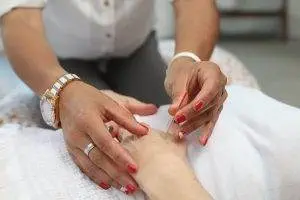
In Traditional Chinese Medicine (TCM), Complex Regional Pain Syndrome (CRPS) is understood as a disruption in the flow of Qi (energy) and Blood in the affected area, leading to pain and dysfunction. According to TCM theory, the underlying causes of CRPS are often related to the stagnation of Qi and Blood, as well as the blockage of meridians (energy channels) that run through the affected limb or body part. TCM treatments aim to restore the smooth flow of Qi and Blood, harmonize the body’s internal balance, and alleviate pain.
Acupuncture, a key component of TCM, is believed to stimulate specific acupoints along the meridians, helping to regulate the nervous system’s response and promote healing. Chinese herbal medicine is also commonly used in TCM to support the treatment of CRPS by addressing underlying imbalances and promoting overall well being. By addressing both the physical and energetic aspects of the condition, TCM aims to restore harmony and alleviate pain in individuals with CRPS.
One study looked at two soldiers whose upper extremities were injured in combat and were later diagnosed with CRPS. When conventional methods did not help relieve pain, they were given one or two acupuncture treatments per week for a few weeks. They had 80% improvement in pain and functionality and with no recurrence at a 20-month follow up.
An individual case study of a 34-year-old with CRPS showed improvement in pain and emotional well-being after a series of acupuncture treatments.
When dealing with Complex Regional Pain Syndrome (CRPS), incorporating certain lifestyle changes, behavioral adjustments, dietary modifications, and home remedies can be beneficial in managing the condition. Here are some recommendations:
Stress Management: Practicing stress-reducing techniques such as deep breathing exercises, meditation, and mindfulness can help alleviate CRPS symptoms. Stress management techniques promote relaxation and can positively impact pain perception.
- Gentle Exercise: Engaging in low-impact exercises like walking, swimming, or yoga can help improve blood circulation, maintain joint flexibility, and reduce muscle stiffness. It is important to consult with a healthcare professional or physical therapist to determine the most appropriate exercise program for your specific situation.
- Heat and Cold Therapy: Applying heat packs or cold compresses to the affected area may provide temporary relief from pain and inflammation. Experiment with both methods to see which works best for you. Remember to protect your skin and avoid extreme temperatures.
- Balanced Diet: Maintaining a healthy and well-balanced diet is crucial for overall well-being. Include nutrient-rich foods such as fruits, vegetables, whole grains, lean proteins, and healthy fats. Avoid excessive consumption of processed foods, refined sugars, and caffeine, as they may contribute to inflammation and worsen symptoms.
- Adequate Hydration: Staying hydrated is important for promoting optimal bodily function and supporting overall health. Aim to drink an adequate amount of water throughout the day to keep your body hydrated and support proper circulation.
- Stress Reduction: CRPS symptoms can be exacerbated by stress. Engaging in activities that promote relaxation, such as hobbies, listening to soothing music, spending time in nature, or engaging in creative outlets, can help reduce stress levels and improve overall well-being.
- Sleep Hygiene: Getting sufficient and quality sleep is essential for managing chronic pain conditions. Establish a regular sleep routine, create a comfortable sleep environment, and practice good sleep hygiene habits like avoiding electronic devices before bed.
It’s important to note that these lifestyle changes, behavioral adjustments, dietary modifications, and home remedies should complement your comprehensive treatment plan and be tailored to your individual needs. Consult with a healthcare professional or a qualified practitioner of Traditional Chinese Medicine (TCM) for personalized guidance and recommendations based on your specific condition and symptoms.
Acupuncture Near Me for CRPS in Los Angeles and Santa Monica
At Art of Wellness Acupuncture in West L.A., we have over 35 years of experience treating neurological conditions and chronic pain of all kinds. Acupuncture is a modality that is particularly suited to treating conditions like CRPS, where it may be difficult to find relief through conventional treatment methods. If you are experiencing excessive pain in one of your limbs, with temperature sensitivity and inflammation, it may be worth seeking out alternative treatment with TCM.
*This article is for education from the perspective of Traditional Chinese Medicine only. The education provided by this article is not approved by FDA to diagnose, prevent, treat and cure human diseases. It should not stop you from consulting with your physician for your medical conditions. Traditional Chinese Medicine is based on Qi, which is an invisible force that usually cannot be observed by modern science. Because science focuses on testing ideas about the natural world with evidence obtained through observation, these aspects of acupuncture can’t be studied by science. Therefore acupuncture and Chinese herbs are often not supported by double-blind, randomized trials, and they are considered alternative medicine therapies in the United States.
How to Treat Hiatal Hernia With Acupuncture and TCM
By Qineng Tan, L.Ac., Ph.D. and Xiaomei Cai, L.Ac., Ph.D.
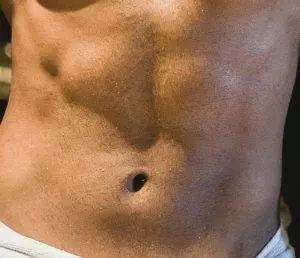
Heartburn and acid reflux? Chest pain or abdominal pain? Vomiting blood, black stool, dark poop? These can be hiatal hernia symptoms. Acupuncture and TCM offer an adjunct or alternative hernia treatment to help relieve hernia pain.
A hernia is what happens when an organ, usually in the abdomen or groin area, pushes through the muscle tissue that surrounds it.
A hiatal hernia occurs when the stomach pushes through the diaphragm—the large muscle that separates your abdomen from your chest.
There is a small opening in the diaphragm—called the “hiatus”— that allows the esophagus to pass through the muscle wall before it connects to the stomach. When a hiatal hernia occurs, the upper part of the stomach pushes through that opening.
It is possible to have a mild hernia and not know it, as it may not cause any pain or other hernia symptoms. A more serious hiatal hernia, though, will cause stomach acid and undigested food to move back up into the esophagus, causing heartburn and possibly chest pain or abdominal pain.
Sometimes it is possible to actually see a hernia, as it may bulge out of the abdomen. Sometimes you can only see it when you cough, or do something strenuous, or even simply stand up.
Hiatal Hernia Symptoms

The most common signs of hiatal hernia include:
- Heartburn and acid reflux: One of the most common symptoms of a hiatal hernia is a burning sensation in the chest due to the regurgitation of stomach acid into the esophagus.
- Chest pain: Some people with a hiatal hernia may experience chest pain that can mimic the symptoms of a heart attack. The pain is often described as a dull, squeezing, or pressure-like sensation.
- Difficulty swallowing: A hiatal hernia can lead to a narrowing of the esophagus, making it difficult to swallow. Individuals may feel a sensation of food getting stuck or feel like they’re choking.
- Belching and hiccups: burping or persistent hiccuping can occur, due to pressure on the diaphragm.
- Regurgitation: In addition to heartburn, people with a hiatal hernia may experience the backflow of food or sour liquid into the mouth.
- Chest discomfort after eating: Some people may experience a burning sensation, pressure, or feeling of fullness in the chest area after eating, because the stomach is pressing into the chest cavity.
- Shortness of breath: Larger hiatal hernias can put pressure on the diaphragm and lungs, leading to difficulty breathing, especially during physical exertion.
- Fatigue and weakness: Chronic symptoms of a hiatal hernia can disrupt sleep, resulting in fatigue.
Hiatal hernias are quite common; they may affect as many as half of all people over 50. Hernias may happen because of a generally weakening of muscle tissues.
Hernias can also occur because of some trauma or injury to the area; some hernias happen after a surgical procedure, due to incisions or scar tissue.
It is also possible to develop a hernia during pregnancy or after giving birth.
In many cases, hernia surgery is considered necessary to treat a hernia that is causing symptoms. Acupuncture and TCM treatment offer a way to treat hiatal hernias that may, in some cases, help people avoid a hernia operation.
Top 10 Types of Hernia
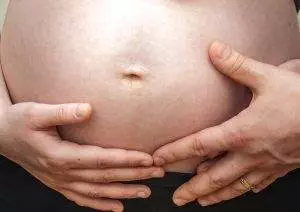
While hiatal hernia and inguinal hernia are the most common types of hernia, there are several other types of hernia, classified mainly according to where in the body they occur.
- Hiatal Hernia: a portion of the stomach protrudes through the diaphragm into the chest cavity, often leading to symptoms like heartburn, chest pain, and difficulty swallowing.
- Inguinal Hernia: Inguinal hernias are the most common type and occur when part of the intestine or abdominal tissue pushes through a weak spot or tear in the lower abdominal wall, often in the inguinal canal. The inguinal canal acts as a passageway for the round ligament of the uterus in women and for the gonadal vessels in men. Inguinal hernias are more common in men and may cause a bulge or swelling in the groin or scrotum.
- Umbilical Hernia: Umbilical hernias occur when the tissue or intestines protrude through a weak spot near the navel (belly button). This type of hernia is more common in infants but can also occur in adults, especially those who are overweight or have had multiple pregnancies.
- Ventral Hernia: Ventral hernias develop in the abdominal wall, often at the site of a previous surgical incision. They can occur when the tissue or intestines push through weakened abdominal muscles, causing a bulge or protrusion.
- Epigastric Hernia: Epigastric hernias appear in the upper abdomen, between the navel and the breastbone. They occur when fatty tissue pushes through weak areas in the abdominal muscles, resulting in a small bump or bulge.
- Groin Hernia or Femoral Hernia: This term is often used to refer to inguinal hernias, which are the most common type of groin hernia. However, it can also encompass other hernias that occur in the groin area, such as femoral hernias. Femoral hernias can sometimes happen due to straining while having a bowel movement.
- Spigelian Hernia: Spigelian hernias are relatively rare and occur along the edge of the abdominal wall, typically below the navel. These hernias may be difficult to diagnose due to their location and can cause pain and discomfort.
- Incisional Hernia: An incisional hernia occurs at the site of a previous surgical incision, where the tissue or intestines protrude through the weakened area. It is more common in individuals who have undergone abdominal surgery.
- Diaphragmatic Hernia: Diaphragmatic hernias occur when abdominal organs, such as the stomach or intestines, protrude through a defect in the diaphragm. This type of hernia can be congenital or acquired and may cause symptoms such as difficulty breathing and chest pain.
- Sports Hernia: Also known as athletic pubalgia, a sports hernia refers to soft tissue injuries or tears in the groin area, specifically affecting the muscles, tendons, or ligaments. It is commonly associated with sports that involve sudden twisting movements, such as soccer or hockey.
Another type of hernia can occur in the back part of the body. You have probably also heard of a “herniated disc.” This condition, which is also known as a “bulging disk,” “prolapsed disc,” “ruptured disc,” or “slipped disc,” is a herniation that occurs between the spinal vertebrae.
There are discs made of cartilage that sit between the vertebrae, which provide cushioning. Sometimes, when there is damage to outer layers of these discs, the gel-like substance that is inside oozes out, breaching the outer wall. This type of hernia can put pressure on the nerves of the spinal column, causing pain.
Hernia Treatment
When a person seeks medical care for a suspected hernia, the diagnostic process typically involves first a physical exam; the doctor will check for swelling or a bulge in the abdomen or groin. Imaging tests, including X-rays or endoscopy, can help a physician see where there is a hernia, and how severe it is.
Initial treatment for hiatal hernia may be conservative, and involve monitoring and making lifestyle changes such as avoiding spicy foods and elevating the upper body during sleep.
Pharmacological solutions might involve antacids, proton pump inhibitors (PPIs) and H2 blockers, which reduce the production of stomach acids.
If these methods do not resolve symptoms of heartburn and reflux, then hernia surgery may be recommended. The most common type of hernia operation is called Nissen fundoplication, which involves wrapping the upper part of the stomach around the lower esophagus to reinforce the lower esophageal sphincter and prevent acid reflux. In some cases, minimally invasive techniques, such as laparoscopic hernia repair, may be used to reduce recovery time and minimize scarring.
Acupuncture and TCM may, in some cases, offer an alternative treatment for hiatal hernia that can help relieve pain, heartburn, and regurgitation.
Can Acupuncture Help Hiatal Hernia?
According to TCM theory, abdominal hernias usually occur due to an imbalance in the middle or lower jiao. The three jiaos are sometimes referred to or translated as the “triple burner,” which illustrates how they keep the center of the body warm and nourished.
In TCM, the upper jiao, middle jiao, and lower jiao correspond to the visceral structure of the midsection, and each one helps to control and harmonize the organ systems contained within it. The middle jiao houses the spleen, stomach, liver and gallbladder, while the lower jiao contains the small intestine, large intestine, kidneys, and bladder.
In Chinese Medicine, heat, cold, dampness, and dryness can be considered pathogenic forces that can cause problems. If there is an accumulation of cold or damp in the upper or lower abdomen, it can cause muscle weakness that leads to the formation of a hernia.
The middle jiao and lower jiao help keep fluids balanced in the abdomen. If the jiaos are not functioning well, then muscle weakness may be the result. Stagnant Qi can also be a factor. Acupuncture treatment helps to strengthen Qi and get it moving.
TCM takes the view that physical, mental, and emotional health are all inextricably linked. Strong emotions and stress can also contribute to the formation of hernias. Repressed feelings of anger or rage are associated with hiatal hernia. It is as if a person is swallowing those feelings, but the body rebels to force them back up.
Acupuncture treatment can help address the effects of prolonged stress and emotional upset. Finding stress relief and relaxation can have a significant effect on the central nervous system, the muscles of the abdomen, and the diaphragm.
Both acupuncture treatment and Chinese herbs can help to reduce acid reflux and GERD symptoms.
If a hernia is severe, then a hernia operation may be required. In these cases, acupuncture and herbs can still help with the healing process. One study showed that electroacupuncture treatment helped to relieve postoperative pain for patients who had undergone hernia surgery.
Regular acupuncture treatment can help to prevent the recurrence of reflux, while helping to reduce the physical effects of emotional stress.
Acupuncture Near Me for Hiatal Hernia in Los Angeles
TCM is an excellent modality for helping to relieve both gastrointestinal disorders and muscular problems. In some cases, a hiatal hernia is a serious mechanical problem that requires surgical intervention. However, in many cases, hernias can be relieved with changes in lifestyle that will help to reduce acid and relieve stress. Acupuncture is worth considering as an adjunct or alternative hernia treatment.
*This article is for education from the perspective of Traditional Chinese Medicine only. The education provided by this article is not approved by FDA to diagnose, prevent, treat and cure human diseases. It should not stop you from consulting with your physician for your medical conditions. Traditional Chinese Medicine is based on Qi, which is an invisible force that usually cannot be observed by modern science. Because science focuses on testing ideas about the natural world with evidence obtained through observation, these aspects of acupuncture can’t be studied by science. Therefore acupuncture and Chinese herbs are often not supported by double-blind, randomized trials, and they are considered alternative medicine therapies in the United States.
How to Treat Appendicitis With Acupuncture and TCM
by Qineng Tan, L.Ac., Ph.D. and Xiaomei Cai, L.Ac., Ph.D.
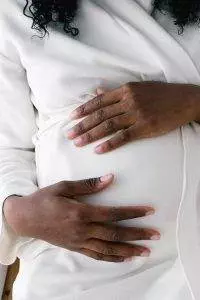
Sudden pain right lower abdomen or pain that starts around your navel? Nausea or vomiting? These may be appendicitis symptoms. Appendix pain is a sign of appendicitis, or an infected and inflamed appendix. Acupuncture and TCM offer an adjunct treatment for appendicitis that can help relieve appendicitis pain.
The appendix is a small, tube-shaped organ that extends off of the lower part of the large intestine. What side is your appendix on? The appendix location is in the lower right quadrant of your abdomen.
What’s appendicitis? Appendicitis causes are generally related to infection and inflammation.
The appendix can become blocked by a bacterial infection, a viral infection, a parasite, or a tumor. Sometimes fecal matter gets into the appendix, causing a blockage.
If the appendix becomes infected and inflamed, it can swell and even rupture; this is often called a “burst appendix,” or ruptured appendix.
If the appendix becomes so swollen that it begins to tear or rupture, stool can leak out into your abdominal area and cause peritonitis, a potentially very dangerous infection.
Acute appendicitis is a medical emergency and requires immediate medical attention.
Studies have shown that acupuncture and TCM treatment can help relieve appendicitis pain and swelling and improve outcomes for patients hospitalized for acute appendicitis.
Appendicitis Symptoms
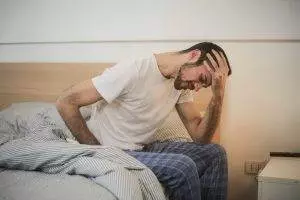
The signs of appendicitis often come on over a short period of time, usually beginning with a sudden pain in the middle of your belly around your navel, and then moving to the lower right side of your abdomen.
Appendicitis symptoms include:
- Sudden pain near or around the navel that migrates to the lower right side
- Sudden pain in the lower right quadrant of the abdomen
- Pain in belly is worse when you cough or are jarred
- Right belly is tender to the touch
- Constipation
- Diarrhea
- Urinary frequency or urinary urgency
- No appetite
- Low grade fever
- Malaise, generally feeling ill
Appendicitis tends to develop through a series of stages. The 4 stages of appendicitis are:
- Early or uncomplicated appendicitis, which is when a blockage has formed and swelling of the appendix begins. At this stage, the pain in the middle of the belly area may be just sort of a vague “stomach ache.”
- The appendix begins to fill with mucus. Without proper blood and lymph drainage, bacteria begin to proliferate inside the appendix.
- The swelling begins to make the tissue of the appendix and the surrounding intestine and bowel walls become stiff, sometimes forming an inflamed mass, which is called an “appendiceal phlegmon.” This can feel like a hard mass in the lower right abdomen when palpated.
- Blocked blood flow causes a lack of oxygen, so the tissues of the appendix become necrotic. At this stage, the wall of the appendix can begin to tear or rupture.
This process usually develops over the course of 12-24 hours. This is why appendicitis is considered a medical emergency. It is very important that anyone experiencing this type of pain and other symptoms seeks urgent care.
Appendicitis Treatments and Appendectomy
Upon being admitted for testing, a person presenting with severe pain in the right abdomen will first need to undergo testing to be sure of a diagnosis of appendicitis.
There are several other conditions which could also cause abdominal pain in this area, including:
- Crohn’s disease
- Mittelschmerz, ovulation pain
- Ovarian cyst that has ruptured
- Ovarian torsion
- Endometriosis
- Ectopic pregnancy
- Pelvic inflammatory disease
- IBD
- Testicular torsion
- Right-sided colitis
- Kidney stone
While undergoing diagnostic testing such as MRI, CT-scan, or ultrasound, it is often common practice for doctors not to administer pain medications, the idea being that to do so might mask symptoms and delay proper diagnosis. This when acupuncture treatment can be particularly helpful. Acupuncture can have a proven analgesic effect for abdominal pain, without any side effects.
In general, appendix surgery is considered the gold standard treatment for acute appendicitis. Appendix removal can be done laparoscopically, or via incision.
Some cases of appendicitis may be treated with antibiotics and other medications over the course of several days or weeks, but often, in a significant number of cases, the appendicitis recurs.
Acupuncture and Chinese herbs can serve as an adjunct treatment for appendicitis patients, helping to relieve abdominal pain, regulate body temperature, and reduce inflammation.
Can Acupuncture Help Appendix Pain?
Appendicitis is an emergency situation, and people should definitely seek immediate medical care if they are experiencing right side abdominal pain and fever.
Acupuncture and TCM herbs can be used as complementary medicine, to help reduce hospitalization time and improve overall outcomes of conventional treatment for appendicitis.
While in some cases, appendicitis surgery may be necessary, there are other options. In some cases a combination of antibiotics to handle the infection, and acupuncture, herbs and moxibustion treatment to help relieve pain and inflammation may help to resolve appendicitis without surgery. This is known as NOTA: non-operative treatment for acute appendicitis.
According to TCM theory, appendicitis is considered to be related to blood stasis and stagnant Qi, as indicated by symptoms like: distended abdomen, nausea and/or vomiting, and a red tongue with a white, greasy coating. If the condition is also characterized by excess heat, then there may also be intense pain and muscle tension in the lower right abdomen, constipation, fever, a dry mouth, and dark-colored urine.
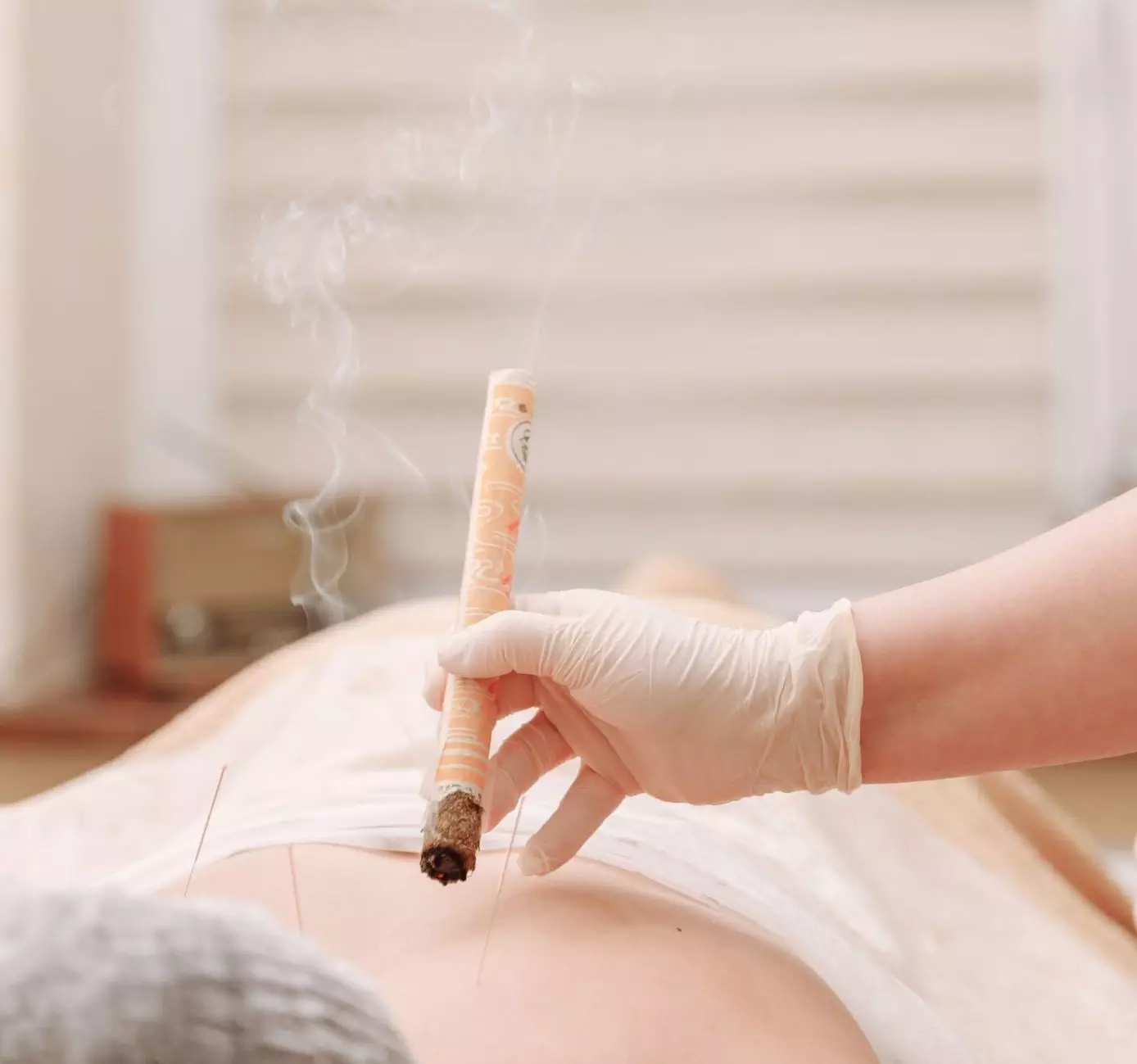
In this situation, an acupuncturist would use acupuncture points targeting the stomach, spleen, and large intestine to help move blood, Qi, and clear heat from the infected area. Moxibustion treatment, which involves burning a small amount of moxa herbs near acupoints, can also help to relieve fever and irritation.
These TCM treatments can help to support and boost the efficacy of conventional medical treatments for appendicitis.
In situations where an appendectomy is indicated, acupuncture and herbs can help speed recovery and help to improve intestinal function after surgery.
One study done on pediatric patients with appendicitis showed that acupuncture helped reduce inflammation and pain.
Another study compared patients hospitalized and treated for appendicitis. One group received antibiotics, pain relief medications, and a special diet. The other group received these treatments, plus acupuncture and herbs. Overall, the patients who received TCM treatment had reduced abdominal pain, more quickly resolved fevers, and were able to leave the hospital days earlier.
Acupuncture, and electro-acupuncture, can also be used to help with recovery and pain relief post-appendectomy, for those patients who do require surgery to remove the appendix.
Acupuncture for Appendicitis Near Me in West Los Angeles
Acupuncture and TCM can often be used in conjunction with conventional medical care as a way to offer additional support for pain relief, recovery, and regaining functionality. In the case of appendicitis, it is vital to seek medical treatment for what can potentially become a life-threatening emergency. Acupuncture and herbs can be used additionally, to help speed recovery from infection, and, when necessary, from surgery. TCM can help patients regain and improve their digestive function.
*This article is for education from the perspective of Traditional Chinese Medicine only. The education provided by this article is not approved by FDA to diagnose, prevent, treat and cure human diseases. It should not stop you from consulting with your physician for your medical conditions. Traditional Chinese Medicine is based on Qi, which is an invisible force that usually cannot be observed by modern science. Because science focuses on testing ideas about the natural world with evidence obtained through observation, these aspects of acupuncture can’t be studied by science. Therefore acupuncture and Chinese herbs are often not supported by double-blind, randomized trials, and they are considered alternative medicine therapies in the United States.